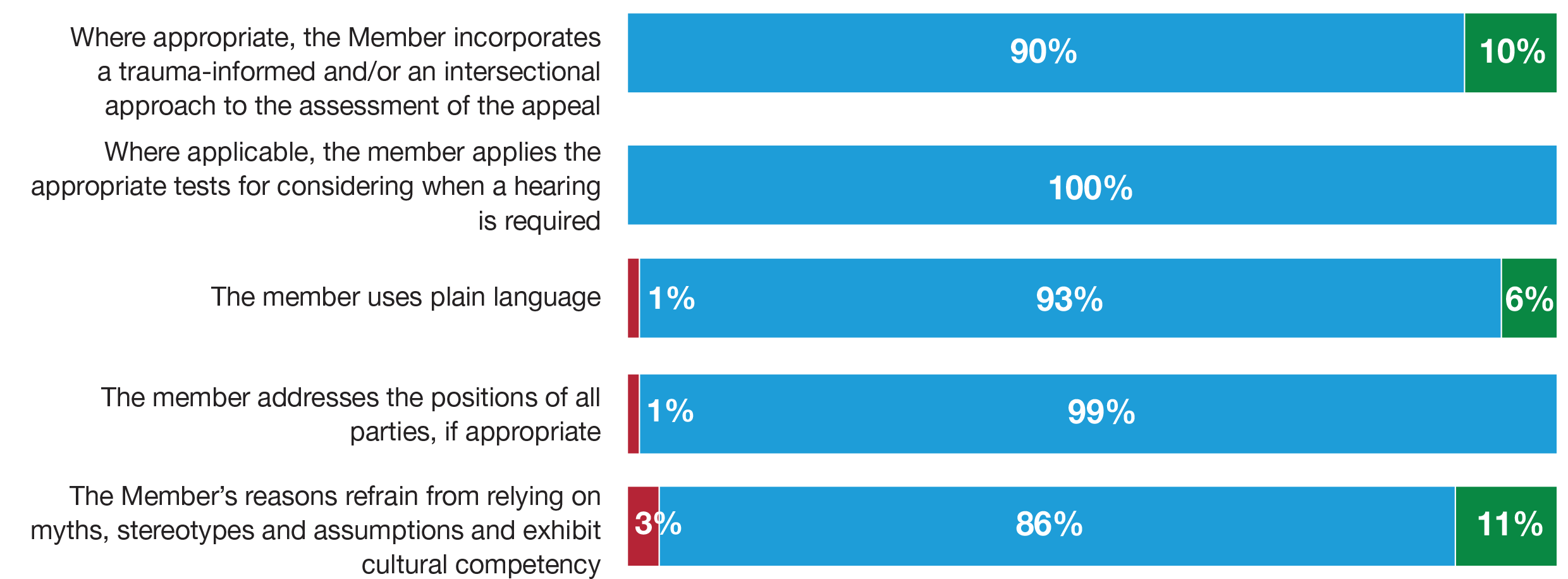Legend
|
|---|
Below expectations
|
Meets expectations
|
Exceeds expectations |
Overall performance
70 cases | 3 themes | 22 questions

Text format – Overall performance
| Percentage of hearings that met or exceeded the high-quality standard: 90% | 10% Below expectations | 90% Meets or exceeds expectations |
Performance by theme

Text format – Performance by theme
| Reasons are complete | 10% Below expectations | 75% Meets expectations | 15% Exceeds expectations |
| Reasons are transparent and intelligible | 7% Below expectations | 77% Meets expectations | 16% Exceeds expectations |
| Supplementary questions | 4% Below expectations | 75% Meets expectations | 21% Exceeds expectations |
Performance by region

Text format – Performance by region
| Eastern region – 28 cases | 8% Below expectations | 74% Meets expectations | 18% Exceeds expectations |
| Central region – 34 cases | 8% Below expectations | 75% Meets expectations | 17% Exceeds expectations |
| Western region – 8 cases | 4% Below expectations | 82% Meets expectations | 14% Exceeds expectations |
Top 5 performing areas by question

Text format – Top 5 performing areas by question
| Where appropriate, the member incorporates a trauma-informed and/or an intersectional approach to the assessment of the appeal. | 90% Meets expectations | 10% Exceeds expectations |
| Where applicable, the member applies the appropriate tests for considering when a hearing is required. | 100% Meets expectations |
| The member uses plain language. | 1% Below expectations | 93% Meets expectations | 6% Exceeds expectations |
| The member addresses the positions of all parties, if appropriate. | 1% Below expectations | 99% Meets expectations |
| The member's reasons refrain from relying on myths, stereotypes and assumptions and exhibit cultural competency. | 3% Below expectations | 86% Meets expectations | 11% Exceeds expectations |
Lowest 4 performing areas by question

Text format – Lowest 5 performing areas by question
| The member succinctly summarizes the main issues. | 24% Below expectations | 49% Meets expectations | 27% Exceeds expectations |
| The member supports findings of fact with clear examples of evidence shown to be probative of these findings. | 23% Below expectations | 47% Meets expectations | 30% Exceeds expectations |
| The member considers all relevant issues and adequately justifies the outcome of the appeal. | 14% Below expectations | 79% Meets expectations | 7% Exceeds expectations |
| The member gives appropriately clear and concise reasons. | 11% Below expectations | 72% Meets expectations | 17% Exceeds expectations |
Considerations
The hearings in the sample were proportionally representive of the general population by member finalizations, region, Guideline 4 and 9, outcome, language, and ministerial intervention.
New members were excluded from the assessment.
For further information and a full report on data contained in this dashboard please see:
Quality Performance in the Refugee Protection Division 2020-21: Report of results.
Recommendations
-
Continue training on high-quality decision writing with an emphasis on point-first and issue based writing, writing for the losing side, and summarizing the decision in opening paragraphs.
-
Provide training on writing convincing reasons, writing on determinative issues, presumptions, and balancing shortness, economy and responsiveness.
-
Highlight decisions that do a good job of linking factual findings to evidence.
-
Develop strategies for ensuring all relevant issues are considered on appeal, addressing the tension between the need for an independent assessment and the need for responsiveness, and writing transparent and intelligible reasons.
-
Remind members that their decisions may provide useful guidance to the RPD.
-
Reinforce member awareness of SOGIE characteristics such as the impact of traumatic experiences on testimony.
-
Consider protocols to ensure that identifying information is removed from SOGIE decisions.